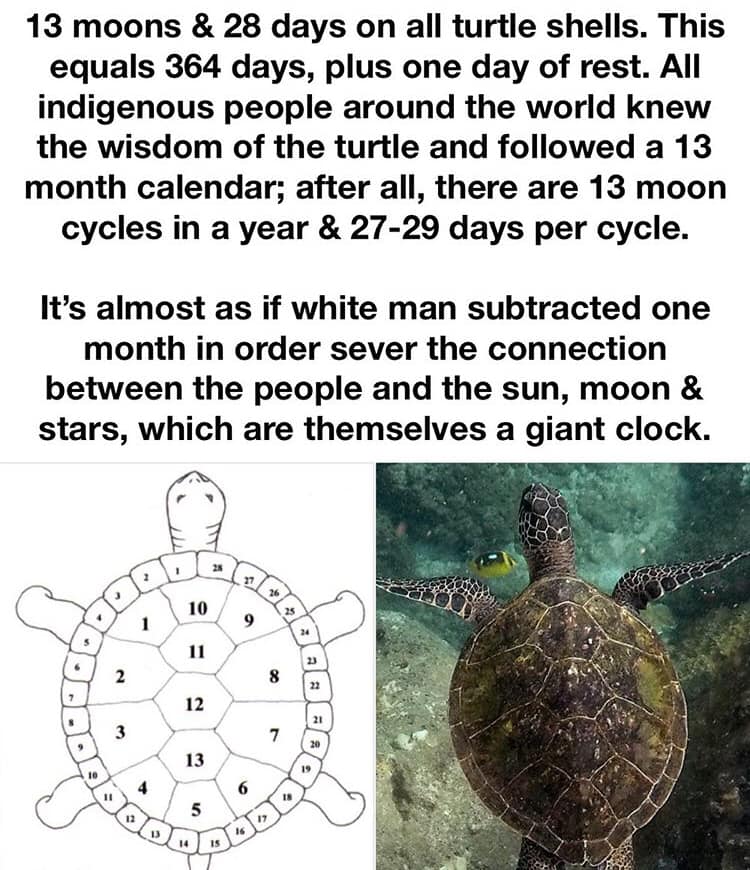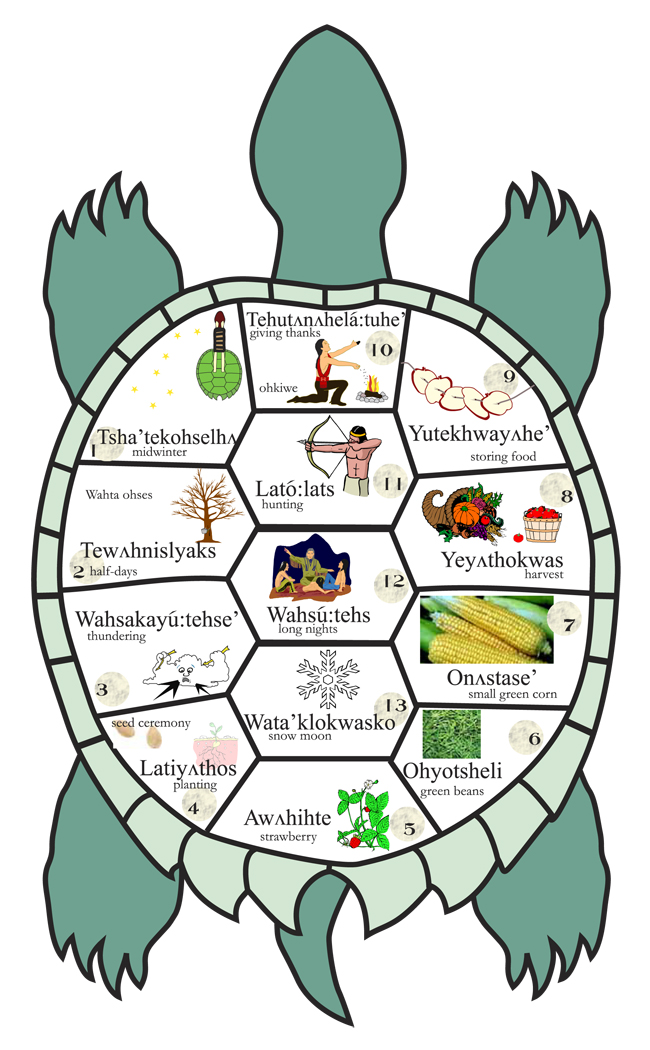
Summer didn’t even say goodbye!
Fall leads straight into: candy month, pie month, and cookie month
“The weather just went from 90 to 55 like it saw a state trooper.”


On a turtle’s back, the pattern of scales establishes the combination of numbers that define the lunar calendar cycle. The circle of scales surrounding the edge adds up to 28, the number of days that comprise the lunar cycle.(28 days from full moon to full moon.) The center of the shell has a pattern of thirteen larger scales, which represent the 13 moons of the lunar calendar.
 Many Native American people look at Turtle’s back as a sort of calendar, with its pattern of 13 large scales standing for 13 moons in each year. As Grandfather says to a young boy, it reminds us that all things are connected and we must live in balance.
Many Native American people look at Turtle’s back as a sort of calendar, with its pattern of 13 large scales standing for 13 moons in each year. As Grandfather says to a young boy, it reminds us that all things are connected and we must live in balance.
Available in hardcover only. Thirteen Moons on Turtle’s Back, by Joseph Bruchac and Jonathan London, with illustrations by Thomas Locker. 1992, 29 pages.
Many Native American people look at Turtle’s back as a sort of calendar, with its pattern of 13 large scales standing for 13 moons in each year. As Grandfather says to Sozap, a young boy in this book’s first story, it reminds us that all things are connected and we must try to live in balance.
In many Native American cultures, each of the 13 moons of the year is said to hold its own story. Turtle holds the mystery of each moon on the shell of its back and gives each moon its power.
From the Potawatomis’ Baby Bear Moon to the Anishinabes’ Maple Sugar Moon to the Lakota Sioux’s Moon When Wolves Run Together, in Native American legend, the natural world is a place of great power where stories help humans understand the mysteries of the earth.
The Native people of North America have always depended upon the natural world for their survival. Watching the changes going on in the natural world with each season, they also look up into the sky and see it changing. In many parts of North America, the Native people relate the cycles of the moon to those seasons. In every year, there are 13 of those moon cycles, each with 28 days from one new moon to the next.
In this collection of poems based on traditional Native stories, Abenaki storyteller and American Book Award recipient Joseph Bruchac collaborates with poet Jonathan London to give voice to the 13 moons of the year and reveal the wonder of the seasons. Spectacular oil paintings by Thomas Locker honor the myths of Native American peoples and the sublime beauty of the land.
Joseph Bruchac is a storyteller, poet, and publisher, and much of his writing draws on his Native American and European heritage. He believes that poetry and storytelling are natural to human beings. His poems and stories have appeared in more than four hundred magazines and anthologies.
Publisher: Philomel Books
Culture Groups: Abenaki, Northern Cheyenne, Potawatomi, Anishinabe, Cree, Huron, Seneca, Pomo, Menominee, Micmac, Cherokee, Winnebago, Lakota Sioux, Abenaki http://oyate.org/.../682-thirteen-moons-on-turtle-s-back...
 The turtle’s back is a significant symbol used in Iroquoian traditions. It represents the creation of Turtle Island also known as the continent of North America, on the turtle’s back or more accurately the “Earth Grasper”, from their Creation Story. A closer look will reveal a pattern of thirteen individual segments on his back which represent each moon of the Iroquoian cycle of seasons. These segments are named according to seasonal practices and natural environmental occurrences e.g. Green Corn, Harvest etc.
The turtle’s back is a significant symbol used in Iroquoian traditions. It represents the creation of Turtle Island also known as the continent of North America, on the turtle’s back or more accurately the “Earth Grasper”, from their Creation Story. A closer look will reveal a pattern of thirteen individual segments on his back which represent each moon of the Iroquoian cycle of seasons. These segments are named according to seasonal practices and natural environmental occurrences e.g. Green Corn, Harvest etc.
Further to this there are twenty-eight platelets which form an edging around the shell. This is the number of days in the moon cycle.
Source: Oneida Language and Culture
This “calendar” is a natural anomaly given to the native people of Turtle Island to remind them of their connection to Mother Earth and that we are not only connected as one people, but we are connected to the natural forces of above and below (Heaven or celestial bodies and Earth).
Maple Sugar Moon
March
March is our Maple Sugar Moon our “Weekapaheek” Moon. It signifies Spring is here and is the New Year for our people, representing new life. In our Maple trees the frozen sugar within begins to melt and starts to become sugar water. The sap starts to leak and indicates these trees are ready to be tapped.
Fishing Moon
April
April is our Fish Moon. This moon is really important to us because this allows us to prep for horticulture. We believe the herring bring the warm weather.
Corn Planting Moon
May
May is our Corn Planting Moon. Corn is the oldest of the Three Sister’s. It’s one of the first crops that indigenous people domesticated, and it is a crucial crop today.
Strawberry Moon
June
June is our Strawberry Moon. The strawberry is a sweet treat and the kickoff to summer. It brings forth the first berry of the year and here in Mashantucket we have a special ceremony that is about forgiveness using the strawberry.
Blueberry Moon
July
July is our Blueberry moon. Mashantucket has a variety of different blueberries throughout the reservation.
Green Corn Moon
August
August is our Green Corn Moon. We have our annual event called Schemitzun, a three day feast we call the celebration of the green corn harvest.
Harvest Moon
September
September is our Harvest Moon. The harvest moon is the last time of the year for us to harvest the last of our crops and prepare ourselves for winter..
Cranberry Moon
October
October is our Cranberry Moon. This is a perfect time of year for harvesting most varieties of cranberries in this region
Falling Leaves Moon
October/November
October/November this is where the idea of a 13th moon comes in sometimes this moon is more in the summertime but a good portion of the time it will fall between October and November and we identify it as the Falling Leaf Moon.
Hunting Moon
November
November is the Hunting Moon. This is the time of year where it’s ideal time to trap animals like beaver and to hunt deer.
Nikommo / Gift Giving Moon
December
December is “Nikommo” our Gift Giving Moon. During this time we prepare for winter. Winter is known as the time of knowledge so we stay inside and share many stories and pass down histories to one another.
This a special time because it shows that our people are of modern people involved in a lot of the traditional activities of today but we also maintain our traditional ways of life and our culture.
Wolf Moon
January
January is our Wolf Moon. During this time food is becoming scarce so wolves stay closer to communities in hopes of scavenging scraps and can be heard howling more at this time of year.
Bear / Snow Moon
February
February is the last our moons, the Snow Moon. This period of the winter is noted to have the heaviest snowfalls historically.